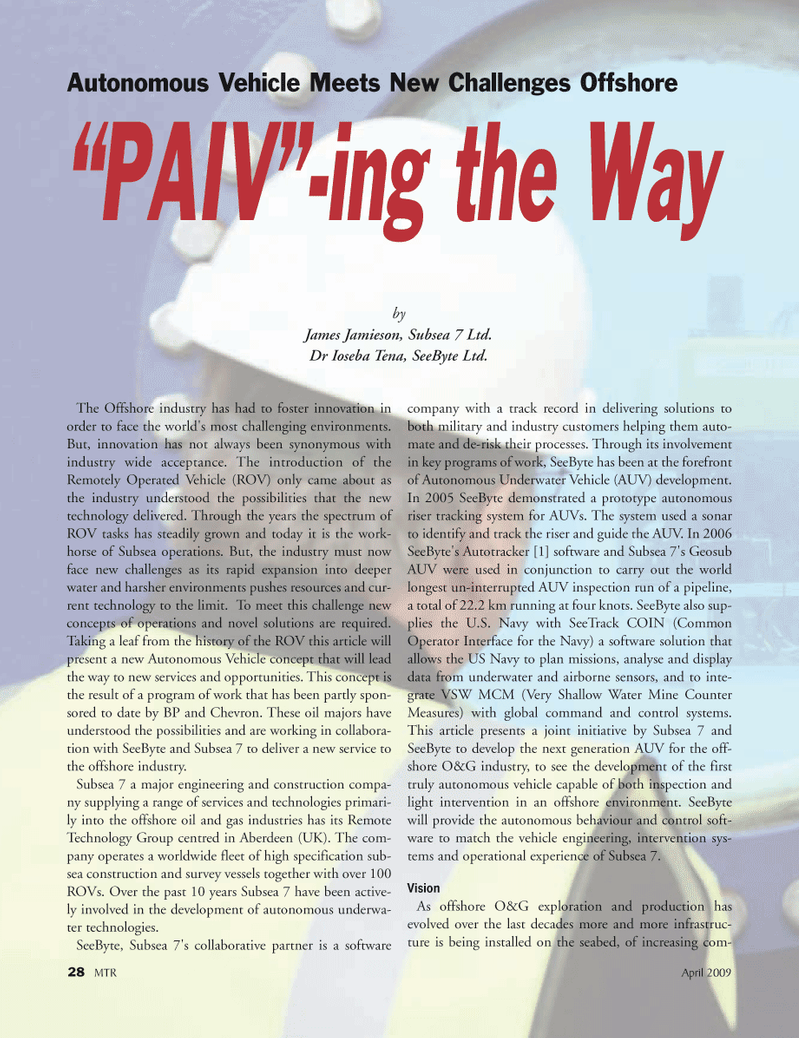
Page 28: of Marine Technology Magazine (April 2005)
Read this page in Pdf, Flash or Html5 edition of April 2005 Marine Technology Magazine
The Offshore industry has had to foster innovation in order to face the world's most challenging environments.
But, innovation has not always been synonymous with industry wide acceptance. The introduction of the
Remotely Operated Vehicle (ROV) only came about as the industry understood the possibilities that the new technology delivered. Through the years the spectrum of
ROV tasks has steadily grown and today it is the work- horse of Subsea operations. But, the industry must now face new challenges as its rapid expansion into deeper water and harsher environments pushes resources and cur- rent technology to the limit. To meet this challenge new concepts of operations and novel solutions are required.
Taking a leaf from the history of the ROV this article will present a new Autonomous Vehicle concept that will lead the way to new services and opportunities. This concept is the result of a program of work that has been partly spon- sored to date by BP and Chevron. These oil majors have understood the possibilities and are working in collabora- tion with SeeByte and Subsea 7 to deliver a new service to the offshore industry.
Subsea 7 a major engineering and construction compa- ny supplying a range of services and technologies primari- ly into the offshore oil and gas industries has its Remote
Technology Group centred in Aberdeen (UK). The com- pany operates a worldwide fleet of high specification sub- sea construction and survey vessels together with over 100
ROVs. Over the past 10 years Subsea 7 have been active- ly involved in the development of autonomous underwa- ter technologies.
SeeByte, Subsea 7's collaborative partner is a software company with a track record in delivering solutions to both military and industry customers helping them auto- mate and de-risk their processes. Through its involvement in key programs of work, SeeByte has been at the forefront of Autonomous Underwater Vehicle (AUV) development.
In 2005 SeeByte demonstrated a prototype autonomous riser tracking system for AUVs. The system used a sonar to identify and track the riser and guide the AUV. In 2006
SeeByte's Autotracker [1] software and Subsea 7's Geosub
AUV were used in conjunction to carry out the world longest un-interrupted AUV inspection run of a pipeline, a total of 22.2 km running at four knots. SeeByte also sup- plies the U.S. Navy with SeeTrack COIN (Common
Operator Interface for the Navy) a software solution that allows the US Navy to plan missions, analyse and display data from underwater and airborne sensors, and to inte- grate VSW MCM (Very Shallow Water Mine Counter
Measures) with global command and control systems.
This article presents a joint initiative by Subsea 7 and
SeeByte to develop the next generation AUV for the off- shore O&G industry, to see the development of the first truly autonomous vehicle capable of both inspection and light intervention in an offshore environment. SeeByte will provide the autonomous behaviour and control soft- ware to match the vehicle engineering, intervention sys- tems and operational experience of Subsea 7.
Vision
As offshore O&G exploration and production has evolved over the last decades more and more infrastruc- ture is being installed on the seabed, of increasing com- 28 MTR April 2009
Autonomous Vehicle Meets New Challenges Offshore “PAIV”-ing the Way by
James Jamieson, Subsea 7 Ltd.
Dr Ioseba Tena, SeeByte Ltd.
MTR#3 (18-33).qxd 3/27/2009 2:04 PM Page 28

 27
27

 29
29
